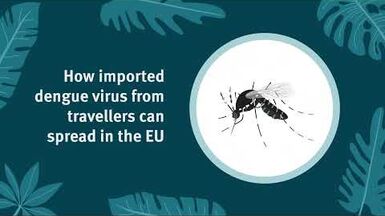Latest ECDC maps on vector distribution introducing enhanced information on spread of mosquitoes, ticks and sandflies in Europe. 2 April 2013: updated map on geographical distribution of Aedes albopictus mosquito now available
ECDC publishes today the latest maps on the geographical distribution of exotic mosquitoes, sandlfies and ticks in Europe, the new maps updated with a more detailed classification of the geographical presence of vector species.
2 April 2013: Erratum - Latest ECDC maps on vector distribution introducing enhanced information on spread of mosquitoes, ticks and sandflies in Europe, 21 March 2013 - updated map on geographical distribution of Aedes albopictus mosquito is now available A correction has been applied to the map showing the geographical distribution of the Aedes albopictus mosquito in Europe, published on 21 March 2013. The Aedes albopictus populations in the Netherlands that were labelled as ‘established’ in the 21 March 2013 version are now displayed as ‘introduced’ in the 2 April 2013 version, indicating that the species has been observed but without confirmed establishment. The regular indoor presence of Aedes albopictus in the Netherlands is limited to man-made artificial settings such as greenhouses with regards to plant importation. The presence and overwintering of these mosquitos in the natural environment is not reported in the Netherlands. Aedes albopictus map, updated 2 April 2013
21 March 2013: ECDC publishes today the latest maps on the geographical distribution of exotic mosquitoes, sandflies and ticks in Europe, the new maps updated with a more detailed classification of the geographical presence of vector species.
The new maps display more comprehensive information on the geographical distribution of both invasive and indigenous species, to allow a better overview of the actual spread of the species. Two categories have been introduced for the presence of invasive mosquito species, distinguishing established and introduced populations. `Introduced’ presence refers to a situation where the species has been observed but without confirmed establishment and ‘established’ presence – where there has been evidence of reproduction and overwintering of the mosquito species. There are also two new categories for absence of indigenous tick and sandfly species: ‘observed absence’ and ‘anticipated absence’. ‘Anticipated absence’ indicates that the species has never been reported in the area and experts estimate a high probability of absence, while the ‘observed absence’ is species’ absence confirmed by evidence, such as field surveys or studies on the species concerned.
The maps show the current known distribution of the vector species at ‘regional’ administrative level (NUTS3). They are published regularly on the website to provide the ECDC stakeholders and the general public with the most up-to-date information on vector distribution.
Outcome of collaborative work of the VBORNET network, the maps are based on data collected by the network members. The group includes medical entomologists and public health experts across Europe, and the network is funded by ECDC. ECDC continues to improve the data collection for the maps: the VBORNET network is therefore looking for experts in vector-borne diseases who are interested in sharing data and networking (experts can contact VBORNET at vbornet@ecdc.europa.eu).






